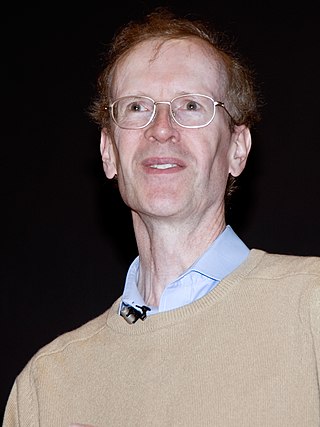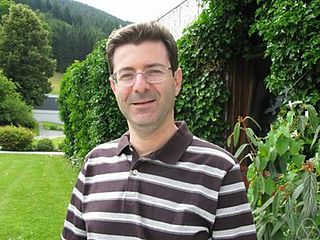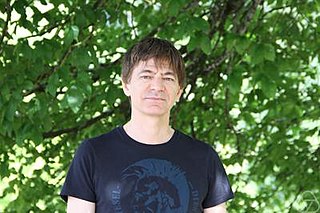
Sir Andrew John Wiles is an English mathematician and a Royal Society Research Professor at the University of Oxford, specialising in number theory. He is best known for proving Fermat's Last Theorem, for which he was awarded the 2016 Abel Prize and the 2017 Copley Medal and for which he was appointed a Knight Commander of the Order of the British Empire in 2000. In 2018, Wiles was appointed the first Regius Professor of Mathematics at Oxford. Wiles is also a 1997 MacArthur Fellow.

The Sadleirian Professorship of Pure Mathematics, originally spelled in the statutes and for the first two professors as Sadlerian, is a professorship in pure mathematics within the DPMMS at the University of Cambridge. It was founded on a bequest from Lady Mary Sadleir for lectureships "for the full and clear explication and teaching that part of mathematical knowledge commonly called algebra". She died in 1706 and lectures began in 1710 but eventually these failed to attract undergraduates. In 1860 the foundation was used to establish the professorship. On 10 June 1863 Arthur Cayley was elected with the statutory duty "to explain and teach the principles of pure mathematics, and to apply himself to the advancement of that science." The stipend attached to the professorship was modest although it improved in the course of subsequent legislation.
In mathematics, the Birch and Swinnerton-Dyer conjecture describes the set of rational solutions to equations defining an elliptic curve. It is an open problem in the field of number theory and is widely recognized as one of the most challenging mathematical problems. It is named after mathematicians Bryan John Birch and Peter Swinnerton-Dyer, who developed the conjecture during the first half of the 1960s with the help of machine computation. Only special cases of the conjecture have been proven.

Richard Lawrence Taylor is a British mathematician working in the field of number theory. He is currently the Barbara Kimball Browning Professor in Humanities and Sciences at Stanford University.
In mathematics, the Hasse–Weil zeta function attached to an algebraic variety V defined over an algebraic number field K is a meromorphic function on the complex plane defined in terms of the number of points on the variety after reducing modulo each prime number p. It is a global L-function defined as an Euler product of local zeta functions.

John William Scott "Ian" Cassels, FRS was a British mathematician.

Sir Henry Peter Francis Swinnerton-Dyer, 16th Baronet, was an English mathematician specialising in number theory at the University of Cambridge. As a mathematician he was best known for his part in the Birch and Swinnerton-Dyer conjecture relating algebraic properties of elliptic curves to special values of L-functions, which was developed with Bryan Birch during the first half of the 1960s with the help of machine computation, and for his work on the Titan operating system.
This is a glossary of arithmetic and diophantine geometry in mathematics, areas growing out of the traditional study of Diophantine equations to encompass large parts of number theory and algebraic geometry. Much of the theory is in the form of proposed conjectures, which can be related at various levels of generality.
Victor Alexandrovich Kolyvagin is a Russian mathematician who wrote a series of papers on Euler systems, leading to breakthroughs on the Birch and Swinnerton-Dyer conjecture, and Iwasawa's conjecture for cyclotomic fields. His work also influenced Andrew Wiles's work on Fermat's Last Theorem.

Bryan John Birch FRS is a British mathematician. His name has been given to the Birch and Swinnerton-Dyer conjecture.
In mathematics, elliptic units are certain units of abelian extensions of imaginary quadratic fields constructed using singular values of modular functions, or division values of elliptic functions. They were introduced by Gilles Robert in 1973, and were used by John Coates and Andrew Wiles in their work on the Birch and Swinnerton-Dyer conjecture. Elliptic units are an analogue for imaginary quadratic fields of cyclotomic units. They form an example of an Euler system.

Karl Cooper Rubin is an American mathematician at University of California, Irvine as Thorp Professor of Mathematics. Between 1997 and 2006, he was a professor at Stanford, and before that worked at Ohio State University between 1987 and 1999. His research interest is in elliptic curves. He was the first mathematician (1986) to show that some elliptic curves over the rationals have finite Tate–Shafarevich groups. It is widely believed that these groups are always finite.
In mathematics, the main conjecture of Iwasawa theory is a deep relationship between p-adic L-functions and ideal class groups of cyclotomic fields, proved by Kenkichi Iwasawa for primes satisfying the Kummer–Vandiver conjecture and proved for all primes by Mazur and Wiles. The Herbrand–Ribet theorem and the Gras conjecture are both easy consequences of the main conjecture. There are several generalizations of the main conjecture, to totally real fields, CM fields, elliptic curves, and so on.

Henri Rene Darmon is a French-Canadian mathematician. He is a number theorist who works on Hilbert's 12th problem and its relation with the Birch–Swinnerton-Dyer conjecture. He is currently a professor of mathematics at McGill University.
In arithmetic geometry, the Tate–Shafarevich groupШ(A/K) of an abelian variety A (or more generally a group scheme) defined over a number field K consists of the elements of the Weil–Châtelet group , where is the absolute Galois group of K, that become trivial in all of the completions of K (i.e., the real and complex completions as well as the p-adic fields obtained from K by completing with respect to all its Archimedean and non Archimedean valuations v). Thus, in terms of Galois cohomology, Ш(A/K) can be defined as
The Millennium Prize Problems are seven well-known complex mathematical problems selected by the Clay Mathematics Institute in 2000. The Clay Institute has pledged a US $1 million prize for the first correct solution to each problem.
Sarah Livia Zerbes is a German algebraic number theorist at ETH Zurich. Her research interests include L-functions, modular forms, p-adic Hodge theory, and Iwasawa theory, and her work has led to new insights towards the Birch and Swinnerton-Dyer conjecture, which predicts the number of rational points on an elliptic curve by the behavior of an associated L-function.
Christopher McLean Skinner is an American mathematician and professor at Princeton University. He works in algebraic number theory and arithmetic aspects of the Langlands program.

Eric Jean-Paul Urban is a professor of mathematics at Columbia University working in number theory and automorphic forms, particularly Iwasawa theory.









